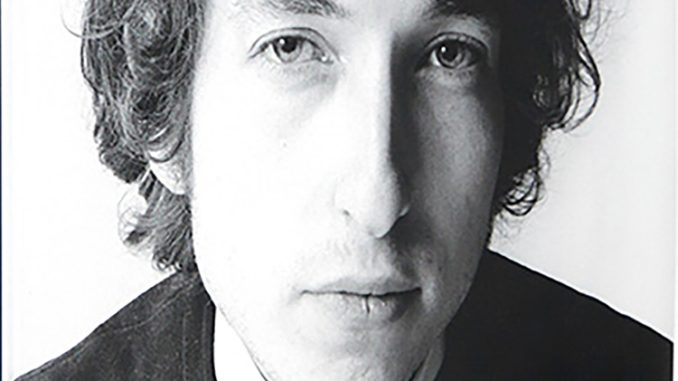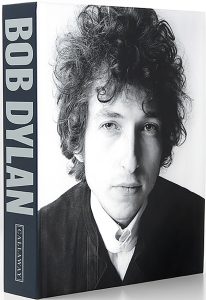
BOB DYLAN: MIXING UP THE MEDICINE
Written & edited by Mark Davidson and Parker
‘There is such pleasure in dipping into the images and scatterings – the morsels of a giant public presence – that sometimes explain him but as often explain us’, writes Bernard Zuel in assessing a new, massive tome on Bob Dylan.
Anyone can do it, and most of us have tried at some point – if only to annoy our Dylan-hating partner.
It starts somewhere around the adenoids, travelling some distance up the long wide plain between tongue and brain accompanied by rhythmic small jerks of the head like a freight train crossing regular junction points, and a squint that is equal parts indifference and suspicion.
“How does it feeeeeel,” you say, your voice taking a long upward curve on that last word, more questing than question mark because you already know the answer and it’s the journey you prefer. “To be on your own, with no direction home, a complete unknown [your voice now like some weird tool that starts with small wired hammer taps and ends with a twisting whine], like a rolling stone.”
Bob Dylan vocal impersonations tend to fall around 1965/66, when a combination of folk song’s laissez-faire attitude to meter, the revelation of rock’s attraction to imperfection, and a man jacked up on Baudelaire, speed and the close smell of one of the more incredible, intense bursts of creativity in modern music, briefly lodged at the centre of popular culture.
 If nothing else – though in 608 pages, 1100 images, 30 essays (from the likes of Michael Ondaatje, Amanda Petrusich, Alex Ross, Allison Moorer, and of course, Greil Marcus), scores of typed and handwritten draft lyrics, notes, ticket stubs, letters (including from Johnny Cash and Bruce Springsteen), tape box IDs, posters, drawings and interview excerpts, there is a whole lot of ‘else’ – this book from the home of the Dylan archives in Tulsa Oklahoma, shows us that novelists, poets and other artists are as susceptible to the temptation to ‘be’ Dylan, even briefly, as we lesser talents.
If nothing else – though in 608 pages, 1100 images, 30 essays (from the likes of Michael Ondaatje, Amanda Petrusich, Alex Ross, Allison Moorer, and of course, Greil Marcus), scores of typed and handwritten draft lyrics, notes, ticket stubs, letters (including from Johnny Cash and Bruce Springsteen), tape box IDs, posters, drawings and interview excerpts, there is a whole lot of ‘else’ – this book from the home of the Dylan archives in Tulsa Oklahoma, shows us that novelists, poets and other artists are as susceptible to the temptation to ‘be’ Dylan, even briefly, as we lesser talents.
Here is part of the opening passage in the essay by Peter Carey – a man well used to inhabiting a voice, in this case a frizzy-haired, free-forming, Gitane-puffing beat hipster who sounds a lot like mid-60s Dylan – describing a visit to Tulsa “in another lifetime” with Russian poet, Yevgeny Yevtushenko, then a return to the Dylan Center with another pack of poets, packed in the back of an Uber.
The driver was a “character” from Dallas.
Where you folk from.
New York, replied the poets.
The driver wore a cowboy hat. Get a rope, he cried.
It was the old weird violence of America. Dang me, I thought. They ought to find a rope and hang me.
Get a rope, the driver insisted. You must a seen it? The Pace Salsa commercial? There was a cook, he said, and some cowboys out on the range and the boys were real unhappy with the Cookie’s new Picante Sauce. It weren’t right. Real Salsa is made in San Antonio by folks who know how picante sauces should taste.
Where was the Salsa made, the TV cowboys asked the TV cookie, a poor physical specimen with a bad case of rhinophyma. Cookie peered at the label before he finally replied, “New York.
Arranged more or less chronologically, taking us, inter alia, from a fifth-grade music class photo of a beaming, round faced Bobby Zimmerman with what was probably meant to be an Indian hand drum, to Dylan’s own musings on musical touchstones in his 2022 book The Philosophy Of Modern Song, this can play as a beautifully packaged mini-history. Every key period of his 60-year career and most of the recordings and film work are represented in some form after all.
This includes, of course, the periods when worked stopped, when career stopped in fear of something more permanent, because, as Petrusich puts it in her examination of the book, Tarantula, which Dylan was writing in 1966, “Dylan feared that he was about to be undone by his own career. He was imagining a moment after his death.” Why? Or from whom? As she sees it, parts of Tarantula “functions as a steady, clear-eyed retort to his most hysterical followers, the ones who claimed ‘to have invented him’, yet still fail to understand that he ‘was more than one person’. They swarmed his home, scouring it for information about his life, his work, his accident…”
Hmm, wonder if they’re reading this? If they’d even accept this as history.
But really, if you’re a Dylan aficionado Mixing Up The Medicine would be far too much like a light skim to justify its claim as history, and its cost, while a Dylan novice would feel like they were simultaneously drowning in detail and desperate for greater explanation, at not small cost. So, if not history, why would someone go there? Two key reasons: experiential and intellectual.
There is such pleasure in dipping into the images and scatterings – the morsels of a giant public presence – that sometimes explain him but as often explain us. That’s the us who queued for a program in the ‘60s, scoured the liner notes in the ‘70s, or might, in the same way a musician like Lee Ranaldo of Sonic Youth does in his essay, search for, abandon and then understand why we want to see meaning when there is none in the juvenile recordings of before-he-was-Dylan Bobby Zimmerman.
And then there’s the surprisingly consistent value from those essays, using an item in the archives as a starting point for discussions of collaboration, deference, inspiration or, as another musician, Allison Moorer, explores in her poetic piece, “discomfort inside, discomfort outside”, and the rewards which come from that.
As Carey says, explaining his plan to transcribe Dylan’s words on his visit, “I had never expected to understand a genius by examining his droppings. What I intended was to show respect.” In its own semi-referential, semi-reverential way, in minutiae and in volume, in droppings and in depth, Mixing Up The Medicine does the same.
Actually, more than respect. Joy Harjo, a poet of the Muscogee Nation, born in Tulsa, whose essay examines ‘Tangled Up In Blue’ and its home album, Blood On The Tracks, sees the song as a constantly changing story that always reflects the singer and the listener in their contexts and their times.
For her, standing outside the Dylan Center, “my childhood is just miles up the road. Blood tales run through our bones, like the streets made of the unspeakable”. But for any of us, the need for what it is we find in the music is the same.
“I bring my restless spirit, disturbed by the blood on the tracks of history, to the altar of music,” she writes. “Love spreads through every sung vowel of becoming.”
Bob Dylan Mixing Up The Medicine is out now, published by Galloway.

